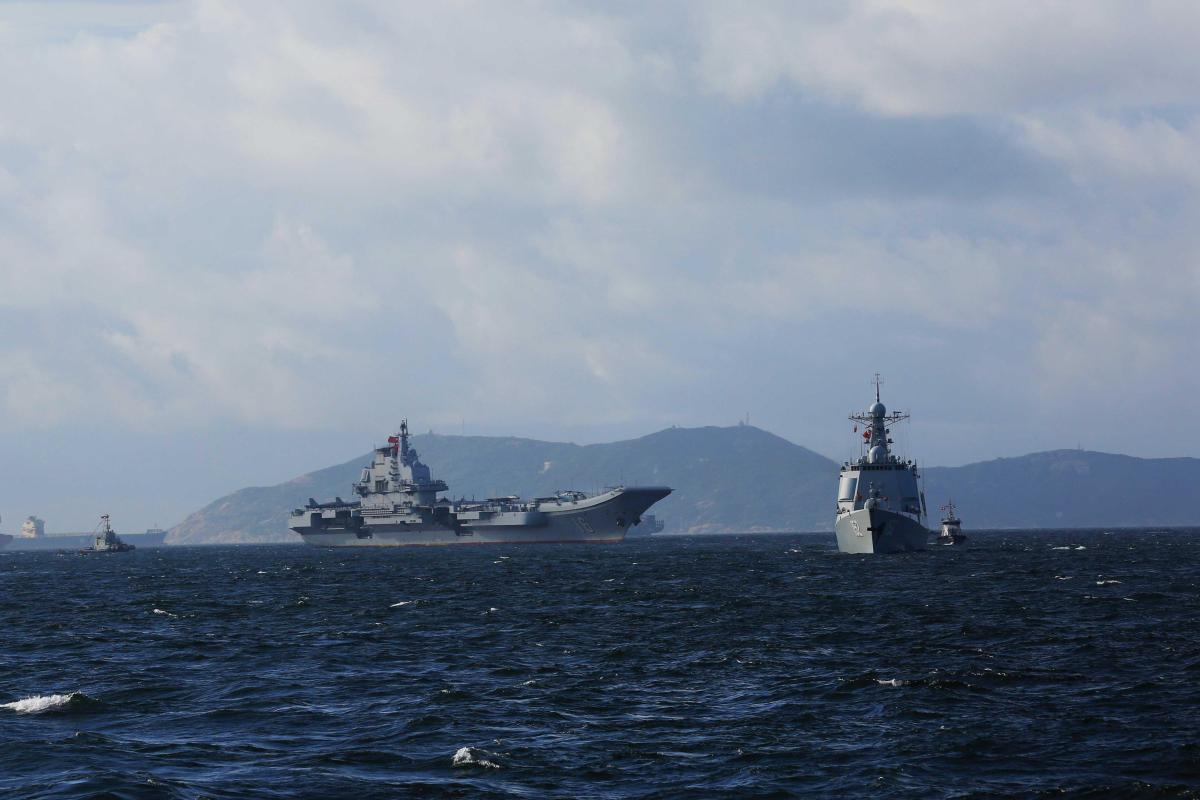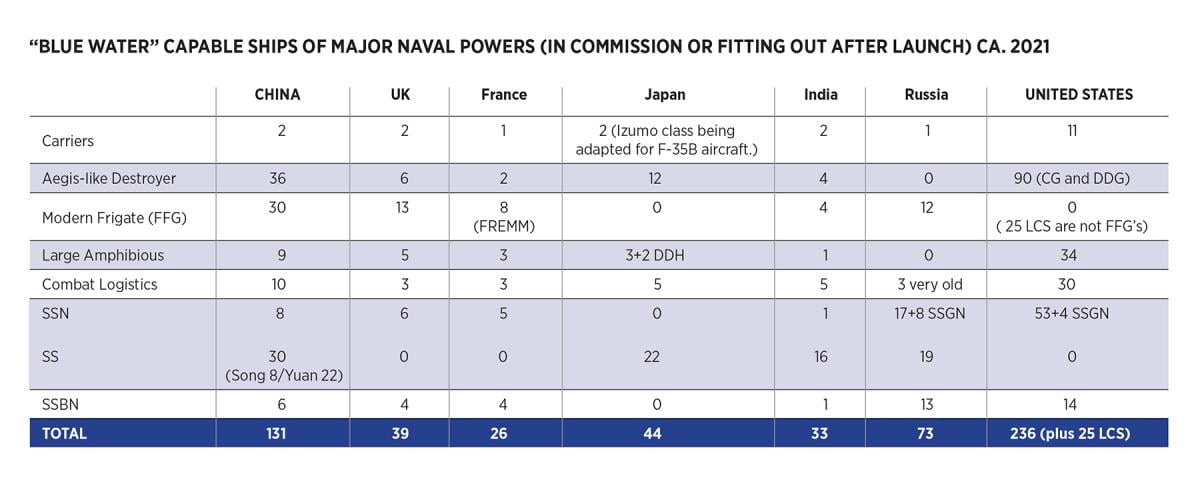It is difficult to appreciate just how fast China has been able to create a blue water navy. One way is to compare it to the other great navies of the world, as the chart below does. This comparison is not a top-to-bottom order of battle inventory in which every ship of every class is counted. Rather it is a comparison of the number of Chinese blue water warships to other nations that historically have demonstrated the ability to operate globally. The ship count totals are projected to the 2020-2021-time frame.
The chart shows that in terms of modern warships and submarines China far outstrips any erstwhile naval competitors, except for the United States. While the PLAN’s far-seas capabilities are impressive when measured against the rest of the world, the U.S. Navy’s still overshadow the PLAN—for now. Virtually all of the U.S. Navy’s warships are blue water capable because they are expected to operate globally. The United States has both a qualitative and quantitative advantage in aircraft carriers, high-end air defense cruisers and destroyers, large amphibious ships, and nuclear attack submarines. On the other hand, all of China’s ships—both the “blue water” ships listed above plus those not included in the chart because they are not “blue water” but are dedicated to “near seas” roles—are homeported in East Asia, providing a “home field advantage” over most of the U.S. Navy that is homeported thousands of miles away. What this means in practice is that on a daily basis virtually all of the Chinese Navy is either in port in China or operating in home waters in and around the First Island Chain. This yields a significant firepower advantage over the U.S. Seventh Fleet.
How Large will the PLAN be in 2035?
Chinese President Xi Xinping wants a “world class force.” He wants the naval modernization associated with becoming world class “to be largely completed by 2035,” just 15 years away. China has yet to publish its intended navy force structure objective, which remains a state secret. A few experts like Rick Joe and James Fanell, however, have published projections of PLAN strength in 2030. Building off their work and others’, here is my estimate of overall PLAN warship strength in 2035.
To speculate on what the PLAN will look like in 15 years, a good starting point is to assess what it has done in the past 15 years. In this short decade and a half, China launched and/or commissioned 131 blue-water capable ships and built approximately 144 other warships destined for operations only in China’s near seas, for a grand total of approximately 275 new warships. During several of these years China’s most modern ship yards were not yet in full production, so it is not unreasonable to forecast that over the next 15 years it could commission or launch 140 more blue-water ships to grow its far-seas capacity and to replace some of today’s blue water ships that were commissioned between 2005 and 2010. In sum, I predict the PLAN’s blue water capable ships in 2035 will number around 270 warships.
This mix will include many more submarines, perhaps doubling the size of the PLAN’s current submarine force. Submarines will increasingly be valued by the PLAN because they cannot, at least not yet, be tracked from space. The number of nuclear attack submarines will be a larger proportion of the PLAN’s overall submarine force. If the nuclear submarine construction hall at Huludao has the capacity analysts suggest, over the next 15 years the PLAN could commission an average of 1.5 SSNs annually.
The need for air cover for surface ships operating away from China leads to the question how large will the PLAN carrier force become? It seems that three will be in operation by the middle of this decade—but at issue is how many more carriers the PLAN thinks it needs, and how many will it have in the water by 2035. The PLAN has elected to take a measured approach to introducing carrier aviation. I see no reason for that to change. A third, larger, catapult-equipped carrier is under construction now and is estimated to be considerably larger than the Liaoning and her near sister—somewhere in the range of 85,000 tons.
This third Chinese carrier is an entirely new and unproven design. On a ship of this complexity, the construction and fitting out process could take some time. As the United States has learned to its dismay with the USS Gerald R. Ford (CVN-78), the urge to stuff as much new technology as possible into a ship can result in expensive delays. The PLAN also needs to invest in new air frames for its carrier fleet, the search for a replacement for its apparently less than optimum carrier capable J-15 “Flying Shark” fighter is already underway, which could turn out to be the “long pole in the tent” on the road to realizing a viable carrier force.
If one assumes a six-year building and outfitting period and the design remains relatively stable, the PLAN could have five to six carriers by 2035. By that time Liaoning, if it is still in commission, will probably have been relegated to the status of an aviation training ship.
PRC shipyards have demonstrated the ability to turn out destroyers, frigates, and corvettes in quantity so building capacity is not an issue. Money, on the other hand, could be an issue, depending on how China’s economy performs over the next decade and a half. The PLAN will have an important voice in determining the precise mix of warships, but it may be forced to make sub-optimal choices if economic or leadership developments cause its budget share to drop
Turning to the near-seas category of warships, I estimate PLAN strength will remain constant. It is currently in the range of 160 ships (144 of which were commissioned since 2005). The biggest change will be replacing the 60 or so single-mission Houbei class fast-attack craft with frigates or corvettes that retain the same antiship cruise missile punch but also add antisubmarine warfare capability.
In summary, in 2035 the PLAN will consist of approximately 270 blue-water ships of the classes listed in the table above, plus another 160 smaller ships, or special mission units. (This total does not include minesweepers, small amphibious craft, and sundry auxiliaries.) The result will be a 430-ship PLA Navy that will be the world’s largest, by far. By any measure this navy will have to be judged “world class.”
Sources for the chart above: DOD Annual Reports to Congress: Military and Security Developments on the PRC 2012, 2018, 2019, Janes Defense Weekly’s announcements of ship commissioning’s, IISS Strategic Balance 2018 and 2019 for all countries listed in the table, Websites for the Indian Navy, Royal Navy, French Navy, Rick Joe’s Diplomat series on the future of the PLA Navy, Ronald O’Rourke’s, semi-annual update of his Congressional Research Service report China Naval Modernization, Office of Naval Intelligence (ONI) The Russian Navy 2015, and ONI’s The PLA Navy: New capabilities and Missions for the 21st Century.




